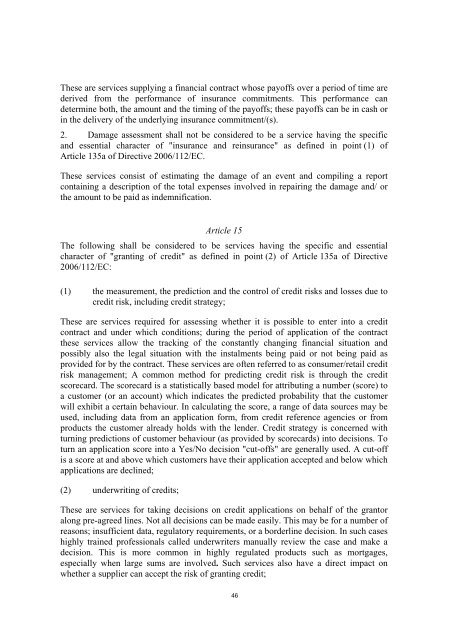taxud/2414/08 - European Commission - Europa
taxud/2414/08 - European Commission - Europa
taxud/2414/08 - European Commission - Europa
You also want an ePaper? Increase the reach of your titles
YUMPU automatically turns print PDFs into web optimized ePapers that Google loves.
These are services supplying a financial contract whose payoffs over a period of time are<br />
derived from the performance of insurance commitments. This performance can<br />
determine both, the amount and the timing of the payoffs; these payoffs can be in cash or<br />
in the delivery of the underlying insurance commitment/(s).<br />
2. Damage assessment shall not be considered to be a service having the specific<br />
and essential character of "insurance and reinsurance" as defined in point (1) of<br />
Article 135a of Directive 2006/112/EC.<br />
These services consist of estimating the damage of an event and compiling a report<br />
containing a description of the total expenses involved in repairing the damage and/ or<br />
the amount to be paid as indemnification.<br />
Article 15<br />
The following shall be considered to be services having the specific and essential<br />
character of "granting of credit" as defined in point (2) of Article 135a of Directive<br />
2006/112/EC:<br />
(1) the measurement, the prediction and the control of credit risks and losses due to<br />
credit risk, including credit strategy;<br />
These are services required for assessing whether it is possible to enter into a credit<br />
contract and under which conditions; during the period of application of the contract<br />
these services allow the tracking of the constantly changing financial situation and<br />
possibly also the legal situation with the instalments being paid or not being paid as<br />
provided for by the contract. These services are often referred to as consumer/retail credit<br />
risk management; A common method for predicting credit risk is through the credit<br />
scorecard. The scorecard is a statistically based model for attributing a number (score) to<br />
a customer (or an account) which indicates the predicted probability that the customer<br />
will exhibit a certain behaviour. In calculating the score, a range of data sources may be<br />
used, including data from an application form, from credit reference agencies or from<br />
products the customer already holds with the lender. Credit strategy is concerned with<br />
turning predictions of customer behaviour (as provided by scorecards) into decisions. To<br />
turn an application score into a Yes/No decision "cut-offs" are generally used. A cut-off<br />
is a score at and above which customers have their application accepted and below which<br />
applications are declined;<br />
(2) underwriting of credits;<br />
These are services for taking decisions on credit applications on behalf of the grantor<br />
along pre-agreed lines. Not all decisions can be made easily. This may be for a number of<br />
reasons; insufficient data, regulatory requirements, or a borderline decision. In such cases<br />
highly trained professionals called underwriters manually review the case and make a<br />
decision. This is more common in highly regulated products such as mortgages,<br />
especially when large sums are involved. Such services also have a direct impact on<br />
whether a supplier can accept the risk of granting credit;<br />
46
















